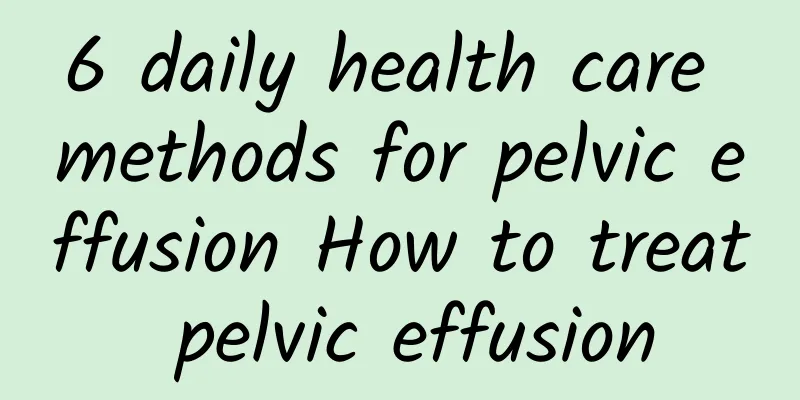|
6 daily health care methods for pelvic effusion How to treat pelvic effusion. Pelvic effusion is a very common gynecological disease, and there are many reasons for pelvic effusion. So once you have pelvic effusion, how should you take care of it in your daily life? Let's learn together. Pelvic effusion refers to the presence of inflammatory exudate in the pelvis, which can occur after pelvic inflammatory disease, adnexitis or endometriosis (pathological). According to the pathological factors, it can be divided into physiological pelvic effusion and pathological pelvic effusion. Physiological pelvic effusion is not a bad thing for women, but pathological pelvic effusion is very harmful. Once a woman suffers from this kind of effusion, she should go to the hospital for treatment in time.
The main symptoms are lower abdominal pain, pain on one or both sides of the lower abdomen, scar adhesions caused by chronic inflammation, and pelvic congestion, which can cause lower abdominal distension, pain, and lumbar pain. They are often more severe when tired, after sexual intercourse, and before and after menstruation. General treatment relieves patients' worries, enhances their confidence in treatment, increases nutrition, exercises, pays attention to the combination of work and rest, and improves their body resistance.
What causes pelvic effusion?
1. During a woman's menstrual period or a few days after her menstrual period, some menstrual blood may flow back along the fallopian tubes into the pelvic cavity, and a small amount of fluid accumulation may be seen on ultrasound.
2. After ovulation, the follicular fluid will flow into the pelvic cavity along with the ruptured follicle. The amount is usually very small and a small amount can be seen under ultrasound. The above two are physiological and will be slowly absorbed by the human body without the need for treatment.
3. Acute and chronic pelvic inflammatory disease.
When an inflammatory reaction occurs, fluid will seep into the pelvic cavity and form an effusion. If accompanied by abdominal pain, fever and other discomfort, it is acute inflammation, and only anti-inflammatory treatment is needed at this time, and the symptoms will be alleviated after treatment.
4. Not paying attention to hygiene during menstruation.
When women have their period, the endometrium will fall off, opening the blood sinuses in the uterine cavity and causing blood clots. This is a very suitable time for bacteria to grow. Therefore, if women do not pay attention to personal hygiene during their period, or do not use sanitary napkins and toilet paper that meet the standards, or have sex during their period, it provides a good opportunity for bacteria to grow and infect, thus leading to female pelvic inflammatory disease.
5. Inflammation spreads to adjacent organs.
Some female friends will suffer from appendicitis or peritonitis, and the female reproductive organs are nearby. If the inflammation is not treated in time, it is easy to spread and eventually lead to female pelvic inflammation. Some female friends suffer from some chronic cervicitis, and the inflammation will circulate through the lymphatic system, eventually leading to inflammation of the female pelvic connective tissue.
6. Postpartum and post-abortion infection.
After childbirth and artificial abortion, female friends are very weak due to a lot of injuries to their bodies, and their body resistance and immunity are relatively low. At this time, the female cervix is also in a state of expansion. At this time, if personal hygiene is not paid attention to, all the bacteria in the vagina and cervix may rise, leading to female pelvic infection.
7. Postoperative infection.
When female friends are doing some artificial surgery, IUD surgery, hysterosalpingography and other surgeries, if the disinfection during the operation is not very strict, it is easy to cause postoperative female infection. And if women do not pay attention to personal hygiene after surgery, do not follow the doctor's instructions for recovery treatment, and have sex too early after treatment, etc., it will cause bacteria to continue to grow, leading to female pelvic infection and female pelvic inflammation. So female friends only need to pay attention to personal hygiene to avoid infection.
Treatment of pelvic effusion
1. General treatment: Relax, enhance confidence in treatment, increase nutrition, exercise, pay attention to the combination of work and rest, and improve body resistance.
2. Treatment of traditional Chinese medicine: Chronic pelvic inflammatory disease is mainly caused by dampness and heat, and mainly focuses on clearing away heat and dampness. Mainly promote blood circulation and remove blood stasis. Prescription: Danshen 18g, white peony root 15g, costus root 12g, peach kernel 9g, honeysuckle 30g, dandelion 30g, Poria 12g, moutan bark 9g, raw earth 9g. When in pain, add 9g of Husuo. Some patients are of condensation and qi stagnation type, and the treatment warms the meridians and dispels cold, promotes qi and activates blood circulation. Guizhi Fuling Decoction is often used with modifications. For those with qi deficiency, add Codonopsis pilosula 15g, Atractylodes macrocephala 9g, and Astragalus 15g.
3. Physical therapy: benign warm stimulation can promote local blood circulation in the pelvic cavity. It can improve the nutritional status of tissues, improve metabolism, and facilitate the absorption and disappearance of inflammation. Commonly used methods include short wave, ultrashort wave, ion penetration (various drugs such as penicillin and streptomycin can be added), and wax therapy.
4. Drug treatment: When using anti-inflammatory drugs, α-chymotrypsin or hyaluronidase can also be injected intramuscularly to promote the absorption of adhesions and inflammation. When some patients have local or systemic allergic reactions, they should stop taking the drug. In some cases, antibiotics are used at the same time as dexamethasone, and dexamethasone is taken orally. When stopping the drug, pay attention to gradually reduce it.
5. Surgical treatment: Tubal hydrosalpinx or tubo-ovarian cysts and other masses can be treated surgically; if there is a small infection focus, patients with repeated inflammation should also undergo surgical treatment. The principle of surgery is to effectively cure the disease and avoid leaving the chance of recurrence. Unilateral adnexectomy or total hysterectomy plus bilateral adnexectomy.
Daily health care methods for pelvic effusion
1. Eat more light food.
The diet should be light. Eat more nutritious foods, such as eggs, tofu, red beans, spinach, etc. Avoid eating raw, cold and irritating foods.
2. Pay attention to personal hygiene.
Strengthen personal hygiene during menstruation, postpartum and after miscarriage, change underwear and sanitary napkins frequently, avoid colds, and avoid overwork.
3. Avoid unnecessary gynecological examinations.
Try to avoid unnecessary gynecological examinations to prevent the spread of infection and inflammation.
4. Avoid sexual intercourse during menstruation.
Avoid sexual intercourse during menstruation to avoid infection. Menstrual pads should be kept clean, and it is best to use sterilized toilet paper.
5. Maintain an optimistic attitude towards life.
The genitals themselves contain pathogenic bacteria. When the body is strong, it is generally not prone to disease. However, due to some reasons, the resistance is reduced, and sometimes pathogenic bacteria will multiply and cause pelvic inflammatory disease. Psychological tension, depression, and poor physical condition make people susceptible to various diseases.
Develop good genital cleaning habits;
Keep the perineum clean and dry, and wash the vulva with warm water every night. Do not use soap or various care solutions to clean the vulva, so as not to affect the vagina's own defense mechanism. Use a special basin, do not wash the vagina with your hands, and do not use a douche to douche the vagina, which is not only easy to destroy the vagina's own defense mechanism, causing flora imbalance and infection, but also may directly inject the bacteria-carrying douche into the uterine cavity when the douche pressure is too high, causing acute pelvic inflammatory disease. |










